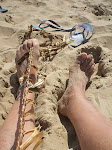It is always interesting to
teach young people who have never done any basket making before. They come with
few preconceptions about what a basket should look like or how to make them and
they also have enormous freedom of expression in
how to solve problems. The down side is that they often try to do impossible
things with combinations of materials that are
too big, too flexible, too rigid or too small.
That, however, is how they will learn what works and what doesn’t. Of course I
can tell them that, in my experience, what they are trying to do will be
difficult, or impossible, and that it probably won’t work, but what will they
have learned? They won’t have had the frustration of trying or the pleasure of finding
their own solutions.
Last week I taught a course in the three main basket making techniques
(plaiting, coiling, stake and strand) for textile and product design students
at Ensci in Paris. This was my
third visit but the first time the course was open to students from departments
other than textiles. It made for a large dynamic group including, I am
delighted to say,six males, (the male
student count for the year is now 10)!
A day and a half on just
one technique group can never be enough but I try to cover basic starts, finishes,
weaves and shaping possibilities in all three
skills. With 27 students it is not
possible to work one to one all the time so I
start each session with a demonstration of techniques and ask them just to
watch. They then commence at their own pace, and I am able to attend to each of
them when they need help. This pedagogy works well for me with large numbers of
students and by the end of the week I find the students are eager for more demonstration
sessions. What I cannot teach them, however, is probably the one thing that is
of supreme importance in basket making and that is how to choose a combination
of material and technique that works. They can
only learn that by handling the materials
themselves. Unlike pottery where a pot can only be made of clay, baskets can be
made from almost anything and so the possible
variations of material and technique are
infinite. I do not ask the college to buy particular materials
so we work with whatever is available. This time we had a supply of seating
materials that came from a company that makes the
plastic woven bistro chairs you see in French bars. This included some rattan,
in one size only, some wooden sticks and lots of coloured plastic lapping.
There were also some sheets of veneers and
lots of different yarns and cords. The students also
brought in some materials that they had
scavenged.
It is fascinating to observe how they solve problems when
left to play on their own with the techniques and materials.
Sometimes they work collaboratively, sometimes they copy someone who they think
has found the answers, sometimes they
ask me and sometimes they just put their work on their heads! I only intervene
when I see a student becoming frustrated and then I make suggestions that leave
them with as many options as possible.
It was an intense week and on the last day they set up an
exhibition of their work. This year staff and students from other departments
came in to see it and to hear what the students thought about the week. It is always
a pleasure for me to teach at Ensci. Thank you to everyone involved, staff and
students.
















No comments:
Post a Comment